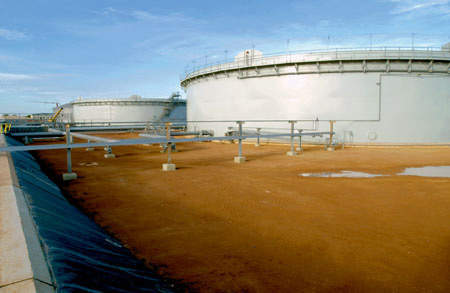
The Khurais oilfield development was the largest of several Saudi Aramco projects intended to boost the production capacity of Saudi Arabia’s oilfields from 11.3 million bpd to 12.5 million bpd by 2009.
The Khurais project as a whole covers three oilfields: Khurais, Abu Jifan and Mazalij. The Khurais field, with an area of 2,890km² and 127km long, located about 250km south-west of Dhahran and 300km north south-east of Riyadh, is the biggest in the project. Abu Jifan covers 520km² south-west of Khurais and Mazalij covers 1,630km² south-east of Abu Jifan.
In 2009, the project added 1.2 million bpd of high-quality Arabian light crude to Saudi Arabia’s export capacity. The Khurais programme also increased the capacity of the Qurayyah seawater injection system by 4.5 million bpd of treated water for injection at the Khurais and South Ghawar fields in 2008. The total project cost is estimated to be about $10bn.
The drilling was completed in February 2009, ten months ahead of the scheduled three-year duration. Production at the oilfield began on 10 June 2009.
Quality of the field
Khurais is located on a large structural trend to the west of, and parallel to, the Ghawar trend.
Because of this superficial resemblance to Ghawar, there were high hopes that the Khurais reservoir would be comparably large; however, it turned out that it was much smaller and not as high quality as Ghawar, though it is still the largest of the proposed projects.
Variable reservoir quality had also been a problem at Khurais. Pilot-scale production at Khurais began in 1963, but the field was never fully developed. It produces Arab light crude.
Project intentions
There are four existing gas / oil separation plants (GOSPs) in operation in the Khurais field and one GOSP in each of the two other fields. Currently, the combined production capacity is 300,000bpd. The scope of the construction programme extending across Saudi Arabia, involved major construction at six separate locations and the development of ten million square metres of land.
At the forefront of the programme was the Khurais central processing facility, providing crude processing and stabilisation facilities.
It was supported by infrastructure including wells and trunklines, an air strip, seawater supply and injection lines, residential facilities for 1,000 personnel and an industrial complex, and product lines. The facilities were completed in November 2008.
In addition to the 1.2 million bpd of Arabian light crude blend that is produced and delivered through the east / west pipeline, the programme also produces 320 million standard cubic feet a day (scfd) of sour gas for Shedgum Gas Plant and 80,000bpd of natural gas liquids (NGL) for the Yanbu Gas Plant.
Contractors for Saudi Aramco’s Khurais project
SNC-Lavalin and Saipem SA, in a joint venture, were awarded a turnkey contract by Saudi Aramco to design and build the seawater injection plants for the Khurais oilfield development programme in early 2006. The four injection plants have a capacity of injecting over four million barrels of treated seawater per day.
In the same year, Veolia Water Solutions & Technologies, Saudi Industries was awarded a turnkey contract to provide a reverse osmosis desalination system for the injection plants. The contract began on a reimbursable basis, converting to a fixed-price, lump-sum turnkey contract once the details were defined.
Foster Wheeler Energy was awarded a front-end engineering and project management services contract for full-field development in July 2005.
The scope of work included a grassroots central processing facility at Khurais, upgrade of support facilities at the Ju’aymah gas plant, inter-field pipelines, utilities and product handling / storage / infrastructure and support facilities.
Foster Wheeler validated the work undertaken and provided overall project management and engineering services for the central processing facility, including certain procurement and construction management services.
Jacobs Engineering with SNC Lavalin and the local Saudi Consulting Services (SaudConsult) carried out the FEED (Front End Engineering Design) package on the expansion of Shaybah. The Shaybah expansion involved installation of new wet crude handling facilities, dehydration and desalter units, a GOSP, pipelines and gas reinjection facilities.
The Southern Area Production Engineering and Production Services Departments (SAPSD and SAPED) were responsible for the start of production from the wells. The two departments were also responsible for the stimulation, installation and testing of the electrical submersible pumps.
SAPED I-Field Data Management Group supports the field through multiphase flow meters, remote-control chokes and permanent downhole monitoring sensors.
This data is transferred from the well site to the control room of the production facility at the field.
Khurais oilfield services
Halliburton was awarded the oilfield services component of the Khurais mega project in early 2006. This three-year contract included a full range of Halliburton’s integrated services and technologies.
The project used 12 rigs to support the drilling and completion of more than 400 wells. They include 232 oil-producers, 119 water-injectors and 58 observation wells. Development of this project was a key contributor to Saudi Aramco’s plan of increasing production capacity.



